
Older people are often portrayed as frail, slow-moving and plagued by aches and pains – but is this correct? Does turning 60 or drawing your pension turn you into an invalid overnight? No! Of course it doesn’t! Not only are these misconceptions wrong, they encourage people to accept sharply declining activity levels as a natural part of aging.
In this guide, we’re going to explain why exercising is even more important as your birthdays rack up and advise on the best exercise machines for mature bodies.
Some of the best current gym gear for 60s, 70s and 80s+

- Weight capacity: 172kg
- Item weight: 25.85kg
- Package dimensions: 73.66 x 50.8 x 27.94 (cm)

- 150kg
- 103D x 56W x 155H cm
- 8kg

- 12 adjustable speed levels
- Digital monitor with remote control
- Weight: 8.89kg

- Weight capacity: 181.44kg (400 lbs)
- Item weight: 31.75kg
- Dimensions: 132.08 x 48.26 x 106.68 cm

- Machine type: Resistance Bands Cardio / Strength: Strength Calories per hour: Not applicable Suited to ages: All ages
- Weight: 1.33kg
- Product Dimensions: 24 x 7.49 x 12.7 cm
- Resistance Levels: 5-125 lbs

- Machine type: Treadmill Cardio / Strength: Cardio Calories per hour: 300 Suited to ages: Adults
- Max speed: 5.5 mph
- Max capacity: 136kg
- Weight: 28.35kg

- Maximum weight capacity: 135kg
- Dimensions: 180 x 63 x 175 cm
- Weight: 87kg

- Weight: 35.7kg
- Maximum weight recommendation: 125kg
- Product dimensions: 89.2D x 53.9W x 146.6H cm
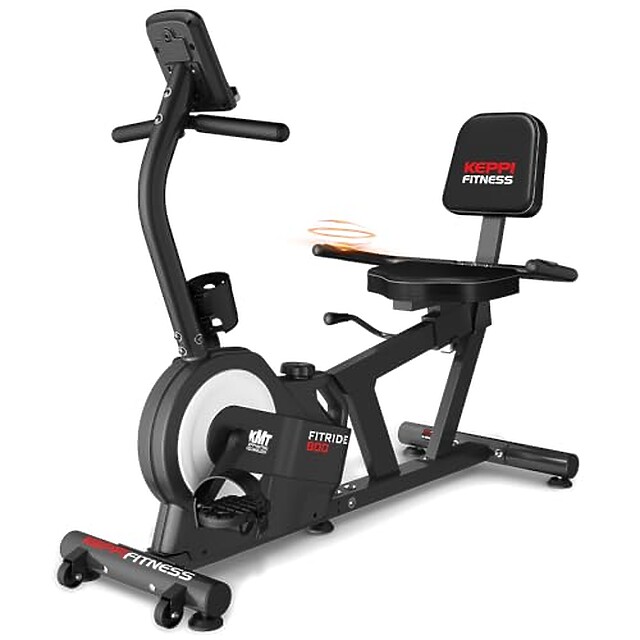
KeppiFitness Recumbent Exercise Bike
Sturdy, reliable and adjustable recumbent bike perfect for home workouts. Ideal for people looking for quiet, comfortable exercise with customizable resistance levels and easy assembly.
Check Latest PriceWhat we liked:
The KeppiFitness RB-380 ticks many boxes for a worthwhile exercise bike. Weighing just 25.85kg, it’s incredibly sturdy, with a weight capacity of 172.37kg, ideal for various users. The 8 levels of magnetic resistance offer plenty of options for tailoring workouts. It’s easy to adjust thanks to stepless sliding and includes heart rate tracking. The comfort seat is beneficial for those needing physical therapy or rehabilitation.
Its whisper-quiet operation is excellent for home use, letting you watch TV without disruption. It's constructed from durable alloy steel and features balance pedals with non-slip designs and adjustable straps. An LED display tracks your metrics and the bike arrives with batteries included. Plus, the five-year warranty and responsive customer service add significant value.
What we didn't like:
Despite a solid overall build, some users found the pulse measurement on the display not entirely accurate. The bike might lack some advanced digital features like connectivity to fitness apps, which could be essential for tech-savvy users. Furthermore, single-person assembly is possible but easier with two. While assembly instructions are clear, it could still be a hurdle for some.
How does it compare to similar bikes?
Compared to other bikes, the RB-380 excels in quiet operation and sturdy build. It competes well on resistance range and comfort. Some options might offer higher tech features, but they can’t match the RB-380's price for quality. Its easy assembly and customer service make it stand out further.
Verdict: Is it worth a buy?
If you're looking for a dependable and quietly operating exercise bike, the KeppiFitness RB-380 is a strong choice. It's best for those needing a durable bike without extra tech frills. Ideal for beginners, seniors, or anyone needing a straightforward workout machine.
- Quick and easy to assemble with clear instructions.
- Whisper-quiet operation allows for undisturbed entertainment.
- Excellent for people with joint issues or requiring rehabilitation.
- Adjustable resistance provides a versatile workout for all fitness levels.
- Comfortable seat with non-slip pedals enhances workout experience.
- Display precision: LED display could be more accurate in measuring pulse.
- Weight: May be heavy to move for some users at 25.85kg.
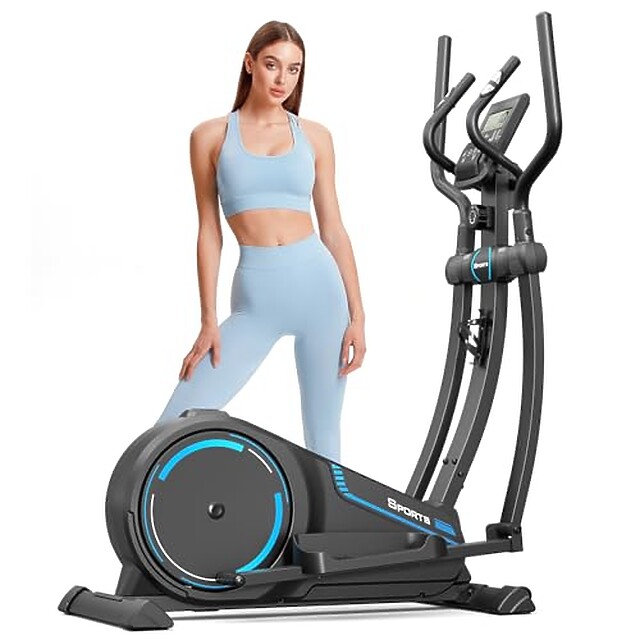
Dripex Elliptical Cross Trainer For Home
Sturdy, reliable cross trainer perfect for people looking for a low-noise workout experience at home. Compact design fits anywhere without compromising on performance or features.
Check Latest PriceWhat we liked:
The Dripex Elliptical CT-100 is a standout choice for home workouts. What truly shines is its hyper-quiet magnetic drive system, which allows for a peaceful workout at any hour without bothering others. It's sturdy too, with a weight capacity of 68kg, making it solid and reliable. I also appreciate the 16 levels of adjustable resistance. It lets you tweak workouts to suit your fitness goals.
The dual handlebar design offers three grip positions, giving an extra dimension to upper body engagement. Additionally, the flywheel weight of 8kg ensures a seamless motion. The 5.5-inch LCD monitor is perfect for tracking workout progress. The non-slip pedals add an extra layer of safety, which I find crucial. I especially love the built-in tablet holder; it keeps my device within reach, making workouts enjoyable as I watch shows or listen to music. The compact size is a bonus, fitting easily into limited spaces and making it easy to move with transport wheels.
What we didn't like:
The Dripex CT-100 isn't without its minor drawbacks. Though it offers a lot, the lack of advanced features like a fancy console might leave tech users wanting. While the assembly is straightforward, it does require about an hour of setup time. It arrives in two packages, which can be a bit cumbersome. Also, while the elliptical is durable, users pointed out that it's not as comparable with high-end gym models. Yet, it more than makes up for it with its excellent features for home use. If you’re expecting a gym-like experience, you might feel a tad underwhelmed.
How does it compare to similar ellipticals?
Compared to similar models, the Dripex CT-100 stands out with its 16 resistance levels and high noise-free operation. While the THERUN Cross Trainer offers similar quietness and compactness, it only has 8 resistance levels. The Elliptical Cross Trainer for Home Gym matches the CT-100 but doesn't feature the same quiet drive system. When considering the price, Dripex provides value, especially with added features like the pulse sensor and multifunctional LCD monitor.
Verdict: Is it worth a buy?
If you need a reliable and quiet home workout machine, the Dripex Elliptical CT-100 is worth considering. It's ideal for users who want a sturdy and space-friendly option with versatile resistance settings. Its practical features like the tablet holder and non-slip pedals make it a solid investment for home fitness users.
- Quiet operation: Less than 20db noise level, ideal for workouts without disturbing others.
- Sturdy design: Supports up to 150kg with stable construction, ensuring safety.
- Compact size: Dimensions allow fitting in limited spaces like home gyms.
- Versatile resistance: 16 levels to customize workout intensity suitable for various fitness goals.
- Convenient features: Includes LCD monitor and pulse sensor for tracking workout metrics.
- Limited stride length: 15.3 inches might not be suitable for taller people.
- Assembly required: Takes about one hour to set up, which might be challenging for some.
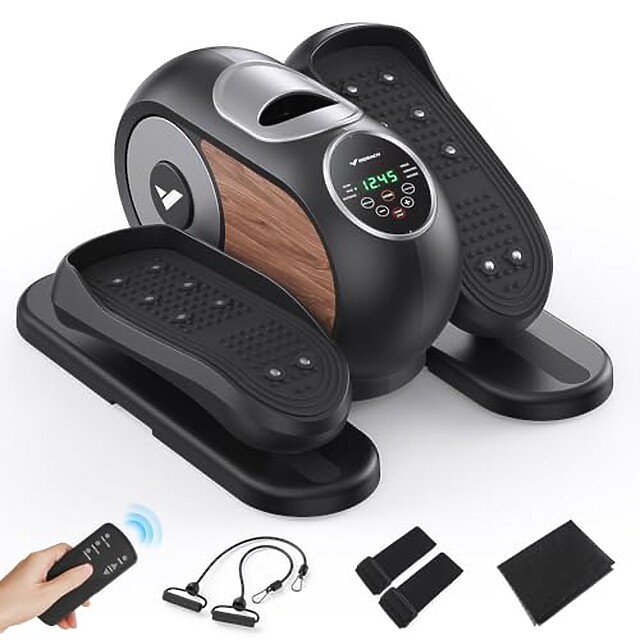
MERACH Under Desk Elliptical Machine
Ideal for seniors and home use, the merach M11 elliptical is sturdy and portable with customizable workout options to enhance mobility.
£129.98 From Amazon UKWhat we liked:
The MERACH Under Desk Elliptical Machine, model Mr-e32, stands out as an excellent option for low-impact exercise. Its compact dimensions and low weight of 8.89kg make it easy to place and move. I appreciated its 12 adjustable speed levels and dual auto/manual modes, which offer flexibility during workouts. The included resistance bands add value by providing an option for upper body workouts. Users seem to love the rubber grips on the pedals and the low noise motor, which lets you work out without disturbing others.
This machine is particularly beneficial for seniors and those undergoing leg rehabilitation, as it aids in improving blood circulation and muscle strength. The LCD monitor also displays essential workout information, making it easy to track progress.
What we didn't like:
Despite its many features, some users found the elliptical a bit noisy. This could be an issue in shared spaces. The safety cut-off after 15 minutes, while a good feature for avoiding overexertion, might interrupt longer sessions. Also, the machine comes with numerous components, but there were a few complaints about the lack of an instruction booklet, which could make initial setup a bit confusing.
How does it compare to similar ellipticals?
Compared to other ellipticals, the MERACH Mr-e32 is lighter and comes with a thoughtful set of accessories. These include a remote control, lubricant and a PVC pad. Its 12 manual and automatic speed levels offer a range of exercises. Although its noise level is slightly higher, its overall functionality and build quality make up for it, according to user reviews. This machine also focuses well on low-impact workouts, setting it apart as an effective option for various users.
Verdict: Is it worth a buy?
This exercise machine is ideal for those looking for a compact, versatile exercise option. It benefits seniors and those with mobility issues due to its low-impact design. With its remote control, LCD monitor and additional resistance bands, it's a worthy addition for anyone wanting to stay active.
- Easy to use: Ready-to-use out of the box with remote control operation.
- Compact and lightweight: Weighs only 8.89kg, making it easy to move.
- Multiple speed modes: Offers 12 adjustable speed levels for varied workouts.
- Low noise motor: Allows for quiet exercise sessions in shared spaces.
- Resistance bands included: Comes with built-in resistance bands for a full-body workout.
- No instruction booklet: Some users noted the absence of a detailed manual.
- Minor noise issues: Can be a bit noisy for some users.
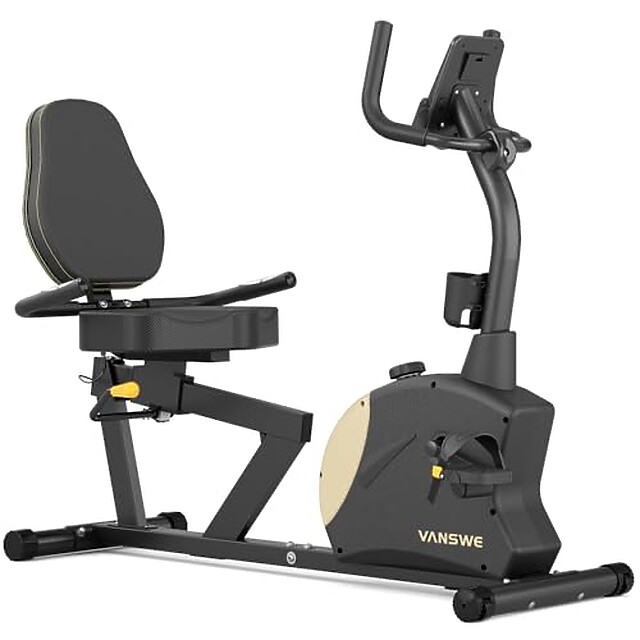
VANSWE Recumbent Exercise Bike
Sturdy, reliable exercise bike perfect for home use. Ideal for people looking for a comfortable, quiet workout. Worth buying for its stable build and excellent warranty.
Check Latest PriceWhat we liked about the vanswe RB912
The Vanswe RB912 impresses with its carbon steel build and robust 182kg weight capacity. It has an ergonomic design and a thick, comfortable seat, making it great for longer workouts. The bike is both stable and portable thanks to its two wheels. Users will appreciate its quiet operation as it won’t disturb others.
Eight levels of magnetic resistance and a digital LED monitor track your heart rate, speed, distance, time and calories burned. With features like a water bottle holder and a quick-release pedal strap, it’s practical. An outstanding lifetime warranty adds peace of mind.
What we didn't like...
While the LED display is functional, it’s rather basic. Some users found that the heart rate monitor doesn't always register accurately. There’s also a minor inconvenience of having to tighten parts occasionally. However, it’s not a major issue. Battery life was short for some, requiring replacements within a couple of days, although the new batteries lasted longer. These are minor setbacks for an otherwise sturdy bike.
How does it compare to similar exercise bikes?
The Vanswe RB912’s sturdy build and comfortable seating set it apart from many bikes. While it lacks advanced digital features, its ergonomic design and quiet operation are strong points. Comparable bikes might offer more tech features, but often at the cost of comfort and durability like the RB912.
Verdict: Is it worth a buy?
This bike is ideal for users wanting a sturdy and comfortable option without needing advanced tech features. Its durability and quiet operation make it a reliable choice for daily use.
- Exceptional comfort: Ergonomic seat and back ensure a comfortable workout experience.
- Quiet operation: Perfect for watching TV or listening to music while exercising.
- Sturdy build: Designed to hold up to 181.44kg, ensuring stability for larger users.
- Easy assembly: Clear instructions and included tools make setup straightforward.
- Comprehensive tracking: LED monitor tracks heart rate, speed, distance, time and calories.
- Heart rate monitor issues: May not register accurately during use.
- Frequent battery replacement: Requires regular battery changes for monitor operation.
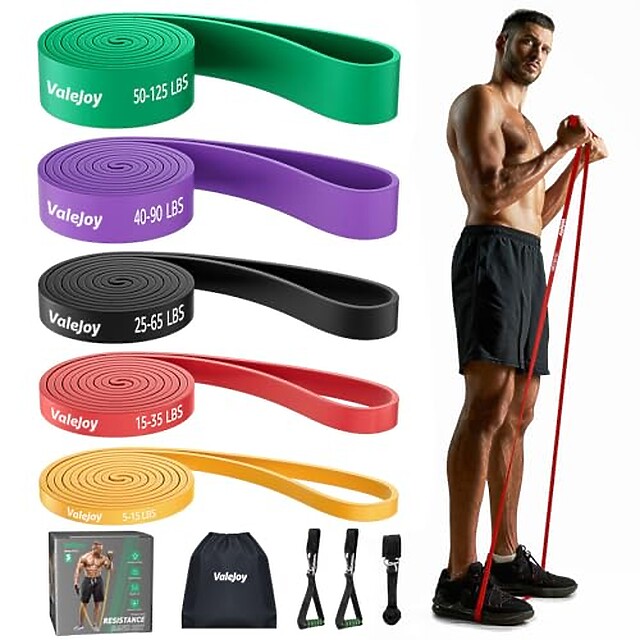
ValeJoy Resistance Bands
Lightweight and versatile, ValeJoy RB-1 is ideal for all fitness levels. Offers effective strength training workouts anywhere, anytime.
Check Latest PriceWhat we liked:
What stands out about the ValeJoy RB-1 is its versatility and durability. Made from 100% silicone, these resistance bands are soft, odorless and boast impressive wear resistance, making them ideal for various workouts. There are five bands with resistance levels from 2.3 to 56.7kg, allowing you to customize workouts for any fitness level. Whether you’re targeting your arms, back, legs, or core, these bands got you covered. Perfect for traveling, this set is lightweight and portable, complete with a storage bag, door anchor and two handles.
The colorful design helps users easily identify which band fits their exercise needs, ensuring quick transitions between workouts. The bands have scored an overall rating of 4.8 out of 5 stars, with users praising their sturdiness and effectiveness.
What we didn't like:
Minor drawbacks include shipping delays, as noted by a user who had to cover additional postage costs due to late delivery. While the bands perform well, timely delivery would improve the experience. Lastly, some may prefer more advanced features, though these bands focus on simplicity and functionality.
How does it compare to similar products?
The ValeJoy RB-1 stands out among resistance bands due to its high quality and comprehensive kit. Thick, durable bands alongside padded handles enhance the workout experience. Compared to other options, it offers a competitive edge in both durability and user satisfaction. It ranks 21st in Resistance Bands.
Verdict: Is it worth a buy?
For those looking for a reliable, portable resistance band set, the ValeJoy RB-1 is an excellent choice. It’s perfect for both beginners and experienced users wanting to enhance their strength training. With quality, versatility and ease of use, it’s hard to beat this set for workouts on the go.
- Durable material: Made from 100% silicone, ensuring long-term use without wear.
- Variety of exercises: Targets multiple body parts, enhancing workout versatility.
- Portable: Lightweight and compact, ideal for travel and easy storage.
- Multiple resistance levels: Customizable to different fitness levels, from light to intense.
- Complete set: Includes handles and door anchor, making more exercises possible.
- Delivery issues: Some delays in shipping reported.
- Potential additional costs: Delayed gifts may incur additional postage costs.
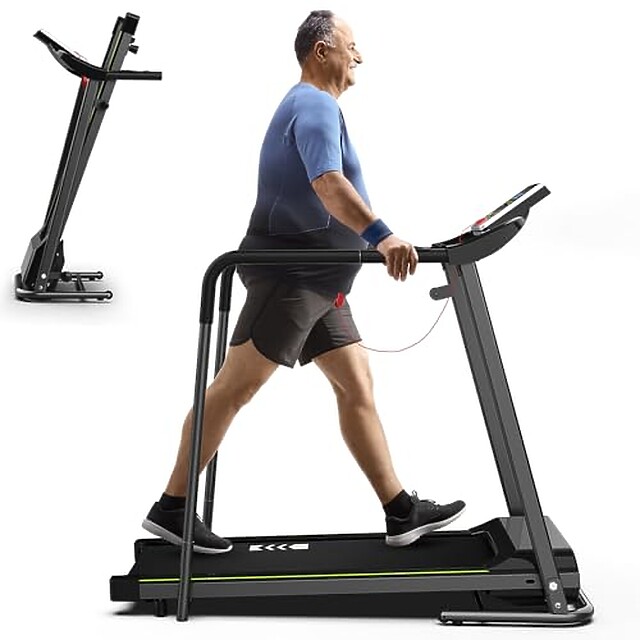
CIIHI Walking Treadmill
Sturdy, reliable and designed for older people, this treadmill offers excellent stability with long handrails and safety key. It’s easy to use and store, making it a worthy investment.
Check Latest PriceWhat we liked:
The CIIHI Walking Treadmill for Seniors stands out for its user-friendly design tailored specifically for older users. Its long handrails provide stability, while the safety key adds an extra layer of security. I appreciate that it’s simple to use, featuring a large font LCD display and straightforward controls. The treadmill's foldable nature and wheeled design make storage and mobility a breeze. This is perfect for small living spaces. With 12 preset modes, the machine caters to various fitness levels. The powerful 2.25 HP motor ensures a smooth experience without feeling overwhelming. Users have praised its stability and quiet operation, making exercise less daunting for older individuals.
What we didn't like:
While the treadmill offers many benefits, it could be improved in a few areas. Some might find the color options limited. This doesn’t impact function but may affect aesthetic preferences. Users have expressed satisfaction overall. A more vibrant design choice could appeal to those wanting more variety. Despite its lightweight design, it still occupies a considerable amount of space, similar to traditional treadmills.
How does it compare to similar exercise machines?
This exercise machine competes well with its peers by prioritizing ease of use and safety features. While other models might offer more bells and whistles, this treadmill focuses on essentials that matter to seniors. Its 136kg capacity and 2.25 HP motor compare favorably, providing adequate speed and strength for indoor walking routines.
Verdict: Is it worth a buy?
This machine is an excellent choice for seniors looking for a reliable and simple exercise solution. With its focus on safety and user-friendliness, it's especially suitable for those looking for easy and effective home workouts.
- Foldable and portable: Easy to store and transport with wheel feature.
- Stability and safety: Long handrails and a safety key provide extra security.
- User-friendly: Large font LCD display simple controls ideal for older people.
- Versatile workout options: 12 preset modes tailored for different fitness levels.
- Quiet and smooth operation: Powerful 2.25 HP motor ensures a comfortable workout.
- Limited color options: Available in only one color, which might not suit everyone's preference.
- Short warranty period: Only offers a 30-day return policy for issues.
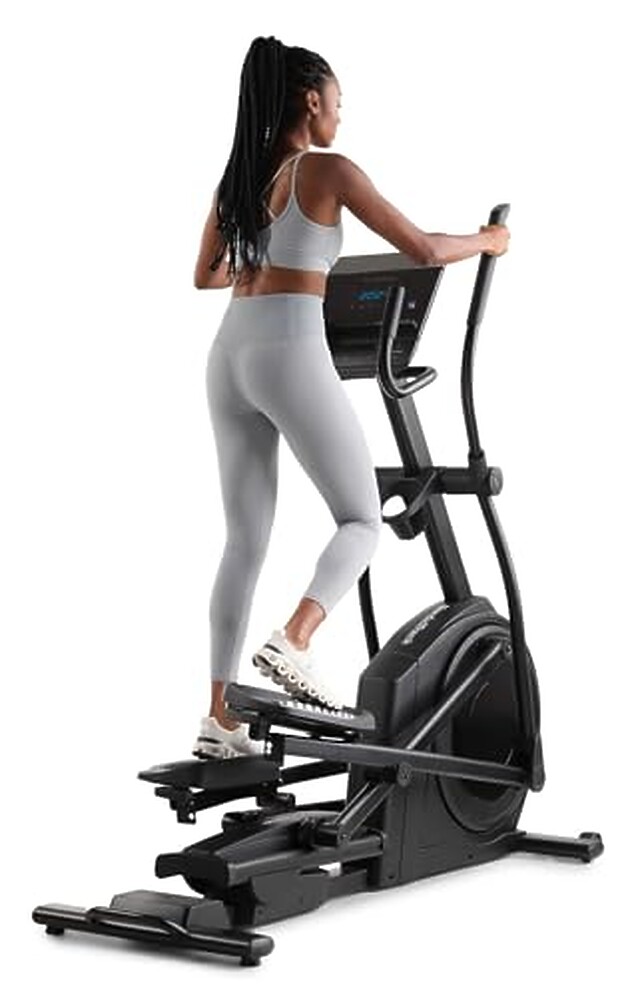
NordicTrack Elliptical Elliptical AirGlide Le
Sturdy, reliable and ideal for people looking for varied workouts with 22 resistance levels and adjustable incline. A worthwhile investment for cardio users.
Check Latest PriceNordicTrack has crafted the AirGlide LE as a versatile elliptical, perfect for tailored workouts. What I liked most are its 22 resistance levels, letting users match workout intensity to their fitness goals. The 5-inch LCD touch screen is easy to use and provides a clear interface for tracking progress. The incline feature is adjustable from -5° to +15% and offers the opportunity to target various muscle groups, enhancing the overall body toning experience. Users up to 135kg can use it comfortably thanks to its robust design. Its magnetic and air resistance mechanisms deliver smooth motion during workouts, supported by a 7kg inertia flywheel.
However, some potential downsides exist. The 5-inch display, while functional, isn't the largest screen out there. This might be a drawback for some users who prefer a bigger display. Additionally, the machine's weight of 87kg makes it quite heavy. This could pose issues for those with limited space or those who need to move it frequently. More advanced features like larger screen sizes and higher weight capacities could improve the experience.
When comparing the AirGlide LE to other ellipticals, its comprehensive customization options stand out. While the weight capacity is decent, competitors like the Commercial 14.9 support up to 159kg, potentially suiting a broader range of users. Still, the fluidity of its movement and overall build quality have won praise.
The NordicTrack AirGlide LE is a solid choice for users looking for a customizable and smooth workout experience. With its 22 resistance levels and adjustable incline, it's ideal for varied workouts. Its sturdy build supports a range of body types, though its weight and screen could be drawbacks for some.
- Customizable resistance: 22 levels allow for tailored workout intensity.
- Interactive training: Compatible with iFIT for guided sessions.
- Adjustable incline: Targets various muscle groups for full-body toning.
- Smooth motion: 7kg inertia provides fluid, realistic movement.
- User-friendly display: 5-inch touch screen for easy tracking and adjustments.
- Large size: Dimensions may require ample space.
- Weight: At 87kg, moving the machine can be difficult.
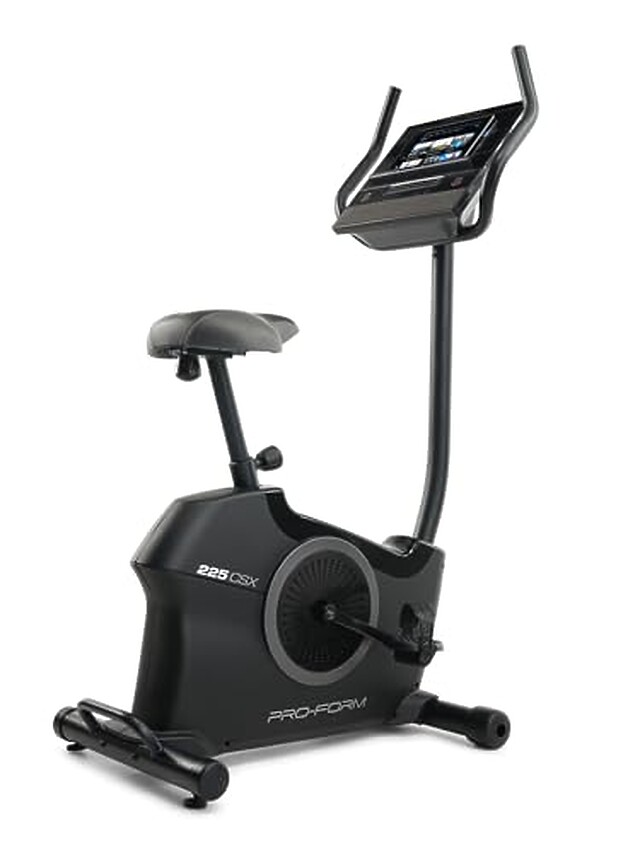
ProForm 225 CSX Upright Bike
Sturdy, reliable and equipped with magnetic resistance that ensures a quiet ride, ideal for home use. Perfect for people who seek a fluid workout experience with interactive training options.
Check Latest PriceThe ProForm 225 CSX Upright Bike offers several impressive features. I particularly liked the 20 digital resistance levels, which allowed me to tailor workouts from easy recovery to intense challenges. The silent magnetic resistance was a standout and provided a smooth and fluid cycling experience. It’s great for indoor use and the sturdy alloy steel frame can support up to 125 kilograms.
The LCD display is straightforward and shows live stats. Plus, the app connectivity with iFIT is a huge plus. With access to over 10,000 workouts, it’s like having a personal trainer at home. The extra-wide ergonomic foot pedals have adjustable straps, ensuring comfort and stability even during intense sessions.
However, there are some drawbacks. While the ProForm 225 CSX has excellent features, some users might find the lack of a more advanced touchscreen a bit disappointing. Also, there aren’t a lot of reviews available yet, which makes it difficult to gauge user satisfaction. A more versatile display could have improved its functionality. But for its features, it delivers a solid indoor cycling experience.
Compared to other exercise bikes, the ProForm 225 CSX excels in offering a wide range of resistance levels and iFIT integration. While it’s not the top-ranked in exercise bikes, its seamless magnetic resistance and adjustable ergonomics make it a worthy competitor.
Overall, the ProForm 225 CSX is great for those looking for versatile workouts with personalized training options through iFIT. Its sturdy build and quiet operation make it ideal for home use. If you want a reliable spin bike, this one’s worth considering.
- Smooth ride: Silent magnetic resistance ensures a quiet, seamless workout.
- Interactive workouts: iFIT connectivity offers over 10,000 workout options for personalization.
- User comfort: Extra wide ergonomic foot pedals with adjustable straps enhance comfort.
- Versatile resistance: 20 digital resistance levels accommodate a range of fitness goals.
- Device integration: Easily connect a device for live workout stats and follow trainers.
- Limited reviews: No user reviews available to gauge broader user satisfaction.
- Warranty details: Only returnable within 30 days, potentially limiting long-term support.
Do you lose muscle as you get older?
Yes. It’s called Sarcopenia and much of it is preventable

Sarcopenia is the medical term for the age-related decline in muscle mass we all experience as we get older. This process begins much sooner than most people realise. Those who lead a sedentary lifestyle can lose up to 5% of their muscle each year from around the age of 30, unless they use exercise machines or some other form of training.
Over time, this decline can cause fatigue, a loss of strength, a slower metabolism, a change in body shape, difficulties with balance, loss of mobility and fragility that increases the risk of fractures and injuries. Sadly, few senior adults achieve the required level of physical activity they’d need to stay healthy.
How do you prevent sarcopenia?
While some degree of sarcopenia is part of the natural aging process, much of it is preventable. Physical activity is, without a doubt, the best way to protect yourself. Not only will the body work to protect muscles that are in use but building muscle mass gives you more ‘surplus’ muscle.
How to start building muscle at 60

Let’s get the hard truth out of the way first: building muscle mass at 60 takes longer than it does at 40 and longer still than it does at 20. On the other hand, if you’ve retired and have no young children in the house, you probably have more time to fit in regular training sessions than you did at those ages.
Resistance band training for seniors is a fantastic way to get and stay in shape
Beginning training can be daunting and you might be worried about injuring yourself. A great place to start is by using resistance bands. These rubber bands are great for gently stretching and strengthening your muscles. They can be used with online instructional videos (search on YouTube) and, because the bands typically come in sets, you can increase the resistance to suit your body’s growing power.
If you’re not sure what exercise machine to buy, grab a set of these bands until you decide on one. They’re affordable, easy to use and can work alongside whatever training machine you get for your home workout.
Building muscle & beginning weight training for seniors
Resistance bands are a good start and a way to build up confidence, but to really make headway with muscle mass you need to use weight machines and dumbbells. Which machines are suited for an older person? All of them! Remember:
Fitness equipment doesn’t carry an age limit

The only thing that might make using certain machines more difficult is an injury or health condition (e.g. arthritis); in which case, listen to your body and don’t push through the pain. Instead, build up strength in the affected area with gentler exercises and try to increase the intensity over time.
Studies have shown that progressive weight training (gradually increasing the amount of weight you lift over time) is good for seniors.
Are free weights good for seniors?
A good starting point for your upper body is to use free weights (dumbbells and barbells) and cable weights. Cable weight machines are the ones that have a bar attached to a cable with the ability to add weights, typically you pull the bar towards you while standing or pull the bar down while seated.
For the lower body, combine free weights with exercises like squats and lunges. Leg press machines allow you to push weights up while seated. It’s normal to experience aches and pains after using this type of equipment.
Older bodies are less efficient at healing, so these may take longer to clear up than they would have when you were younger. This isn’t a sign that you should stop exercising, try to stick to your routine.
Why is it important for older adults to exercise?
There’s many reasons to stay in shape as we age. For starters, there are many diseases that you can help protect yourself against with regular use of training equipment and a healthy exercise program.
According to the NHS website:
people who are active have a lower risk of heart disease, stroke, type 2 diabetes, some cancers, depression and dementia.
Some other benefits to staying in shape as you age are:
- More energy
- Increased strength for everyday activities and family
- Reduce body fat and look better!
- Improvements to balance & posture
- Increased mobility
What are the best leg exercise machines for elderly people living in the UK?
- Recumbent bikes – This reclined position cycles a lot easier on the back than the upright versions yet offer a seriously good form of exercise for your lower body and legs. They’re even suitable if you’ve suffered from a bad back door have other injuries. (Check with the Doc first, of course…)
- Elliptical machines – These standing exercise machines are big and bulky but there’s not much better for toning up legs and working out your lower body. They’re also incredibly good at burning off calories and keeping you in overall good shape. You can go at your own pace and there will be programs and resistance settings to suit any age or beginner.
- Resistance bands – There’s likely an infinite number of ways people find to use these things. These simple rubber bands are extremely cheap but offer a range of exercises that seniors can use to work their legs at home easily. Many exercises can be done sitting down. See below for examples:
How much should senior adults exercise?
As well as looking at what kinds of exercise machines, gym gear and training older adults should do, we’d better touch on how much of it we should be doing.
The best source of this is the WHO, who have specific guidelines for the amount of exercise adults 65 or older should undertake.
- At least 150 min of moderate-intensity aerobic activity, or at least 75 min of vigorous-intensity aerobic activity, or an equivalent combination.
- Aerobic activity should be performed in bouts of at least 10 min duration.
- For additional health benefits, undertake up to 300 min of moderate-intensity or 150 min of vigorous-intensity aerobic activity, or an equivalent combination.
General exercise tips for seniors

In addition to weightlifting and using various exercise machines to improve your fitness as you get older, there’s plenty of other proven ways to and maintain muscle mass. It’s as they say, if you don’t use it you’ll lose it!
You’re never too old to start running
Going for a jog is one of the best things you can do for your physical and mental health. Check out our guide: Am I Too Old To Start Running At 60?
Swimming is a good exercise for seniors
Swimming is one of the best ways of working out the entire body and is particularly suited to people who suffer from arthritis and other joint conditions because the water supports your body weight, allowing you to move more freely.
Indoor or outdoor cycling is perfect for older people
Cycling is another brilliant exercise, especially for those who have bad knees. Again, pressure on the joints is reduced because your bodyweight is kept off your knees, allowing them to move and build strength without that extra stress. You’ll definitely want to look into recumbent bikes too, as this reclined cycling lends itself well to anyone with problems with either back or knees.
What age should you stop exercising?
Quick answer: never stop training and working out, if you want to keep yourself fit and healthy. Check out some of the oldest body builders on the planet for some inspiration. While you might not want to go to that length, it shows age doesn’t mean you can’t achieve incredible things with your training.
Age is no barrier to being active and getting older doesn’t mean you have to accept a reduction in mobility. Health conditions can unfortunately make certain movements more difficult and even painful, but there are ways to work around this.
Exercise: not just for young people!
The narrative around young people exercising is one of aesthetics and hitting impressive targets, like bench pressing a certain number or completing a marathon. For older people, it’s sometimes assumed that they aren’t interested in these things or that they’re not capable of achieving them (wrong!).
The sheer range of exercise machines available mean everyone can find a way that suits their lifestyle and improve their health and fitness.
What’s missing is that exercise becomes crucial for quality of life as you get older because your body will naturally lose muscle mass. Your golden years will only be golden if you can enjoy good health, so take positive steps to protect your muscles by regularly engaging in some form of exercise.
References and further reading
- NCBI – The Intensity and Effects of Strength Training in the Elderly
- NHS – Exercise as you get older
- BMJ – Physical activity is medicine for older adults
- World Health Organization – Global recommendations on physical activity for health









